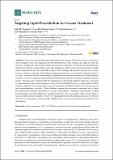Por favor, use este identificador para citar o enlazar a este item:
http://hdl.handle.net/10261/232595COMPARTIR / EXPORTAR:
 SHARE
BASE SHARE
BASE
|
|
| Visualizar otros formatos: MARC | Dublin Core | RDF | ORE | MODS | METS | DIDL | DATACITE | |

| Título: | Targeting Lipid Peroxidation for Cancer Treatment |
Autor: | Clemente, Sofia M.; Martínez-Costa, Oscar H. CSIC ORCID; Monsalve, María CSIC ORCID ; Samhan-Arias, Alejandro K. CSIC ORCID | Palabras clave: | Cancer Peroxides LOX COX Fenton reaction Iron Ferroptosis Nanoparticles |
Fecha de publicación: | 2020 | Editor: | Multidisciplinary Digital Publishing Institute | Citación: | Molecules 25(21): 5144 (2020) | Resumen: | Cancer is one of the highest prevalent diseases in humans. The chances of surviving cancer and its prognosis are very dependent on the affected tissue, body location, and stage at which the disease is diagnosed. Researchers and pharmaceutical companies worldwide are pursuing many attempts to look for compounds to treat this malignancy. Most of the current strategies to fight cancer implicate the use of compounds acting on DNA damage checkpoints, non-receptor tyrosine kinases activities, regulators of the hedgehog signaling pathways, and metabolic adaptations placed in cancer. In the last decade, the finding of a lipid peroxidation increase linked to 15-lipoxygenases isoform 1 (15-LOX-1) activity stimulation has been found in specific successful treatments against cancer. This discovery contrasts with the production of other lipid oxidation signatures generated by stimulation of other lipoxygenases such as 5-LOX and 12-LOX, and cyclooxygenase (COX-2) activities, which have been suggested as cancer biomarkers and which inhibitors present anti-tumoral and antiproliferative activities. These findings support the previously proposed role of lipid hydroperoxides and their metabolites as cancer cell mediators. Depletion or promotion of lipid peroxidation is generally related to a specific production source associated with a cancer stage or tissue in which cancer originates. This review highlights the potential therapeutical use of chemical derivatives to stimulate or block specific cellular routes to generate lipid hydroperoxides to treat this disease. | Descripción: | © 2020 by the authors. | Versión del editor: | http://dx.doi.org/10.3390/molecules25215144 | URI: | http://hdl.handle.net/10261/232595 | DOI: | 10.3390/molecules25215144 | E-ISSN: | 1420-3049 |
| Aparece en las colecciones: | (IIBM) Artículos |
Ficheros en este ítem:
| Fichero | Descripción | Tamaño | Formato | |
|---|---|---|---|---|
| Targeting_Clemente_PV_Art2020.pdf | 2 MB | Adobe PDF |  Visualizar/Abrir |
CORE Recommender
PubMed Central
Citations
28
checked on 08-abr-2024
SCOPUSTM
Citations
35
checked on 24-may-2023
WEB OF SCIENCETM
Citations
33
checked on 26-mar-2023
Page view(s)
71
checked on 23-abr-2024
Download(s)
214
checked on 23-abr-2024

